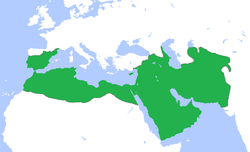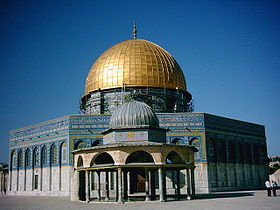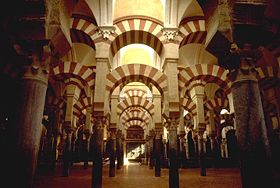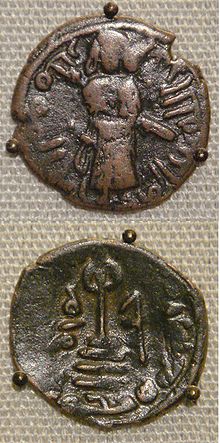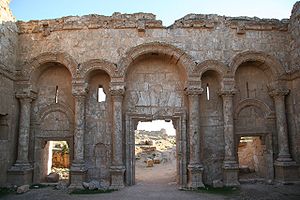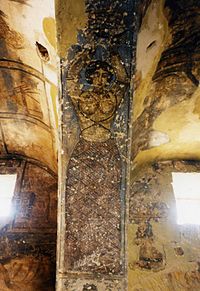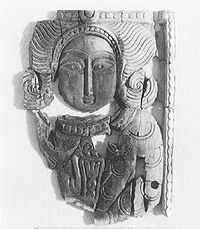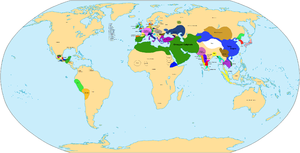- Umayyad Caliphate
-
Umayyad Caliphate
بنو أمية
Banu Umayyah (Arabic)← 
←
←
661–750  →
→
 →
→Flag
Umayyad Caliphate at its greatest extent. Capital Damascus Capital-in-exile Córdoba Language(s) Arabic official, Aramaic, Armenian, Berber languages, African Romance, Coptic, Georgian, Greek, Hebrew, Turkish, Kurdish,[1] Middle Persian, Mozarabic Religion Sunni Islam Government Caliphate Caliph - 661–680 Muawiya I - 744–750 Marwan II History - Muawiya Caliph 661 - The Abbasid defeated and killed Marwan II / Fall of the dynasty* 750 Area - 750 7,000,000 km2 (2,702,715 sq mi) Population - 7th century est. 62,000,000 Currency Umayyad Dinar Today part of  Afghanistan
Afghanistan
 Algeria
Algeria
 Andorra
Andorra
 Armenia
Armenia
 Azerbaijan
Azerbaijan
 Bahrain
Bahrain
 Cyprus
Cyprus
 Egypt
Egypt
 France
France
 Georgia
Georgia
 Gibraltar(UK)
Gibraltar(UK)
 Iran
Iran
 Iraq
Iraq
 Israel
Israel
 Jordan
Jordan
 Kazakhstan
Kazakhstan
 Kuwait
Kuwait
 Kyrgyzstan
Kyrgyzstan
 Lebanon
Lebanon
 Libya
Libya
 Mauritania
Mauritania
 Morocco
Morocco
 Northern Cyprus
Northern Cyprus
 Oman
Oman
 Pakistan
Pakistan
 Palestine
Palestine
 Portugal
Portugal
 Qatar
Qatar
 Russia
Russia
 Saudi Arabia
Saudi Arabia
 Spain
Spain
 Syria
Syria
 Tajikistan
Tajikistan
 Tunisia
Tunisia
 Turkey
Turkey
 Turkmenistan
Turkmenistan
 United Arab Emirates
United Arab Emirates
 Uzbekistan
Uzbekistan
 Yemen
Yemen
 Western Sahara
Western SaharaThe Umayyad Caliphate (Arabic: بنو أمية, trans. Banu Umayyah; "Sons of Umayyah") was the second of the four major Arab caliphates established after the death of Muhammad. It was ruled by the Umayyad dynasty, whose name derives from Umayya ibn Abd Shams, the great-grandfather of the first Umayyad caliph. Although the Umayyad family originally came from the city of Mecca, their capital was Damascus. At its greatest extent, it covered more than five million square miles (13,000,000 km2), making it one of the largest empires the world had yet seen,[2] and the fifth largest contiguous empire ever to exist. After the Umayyads were overthrown by the Abbasid Caliphate, they fled across North Africa to Spain (Al-Andalus), where they established the Caliphate of Córdoba, which lasted until 1031.
Contents
Origins
History of the Arab League member states Arab CaliphateRashidun 632-661 Umayyads 661-750 Abbasids 750-1258 Fatimids 909–1171 Mashriq DynastiesAD Tulunids 868-905 Hamdanid dynasty 890-1004 Ikhshidid dynasty 935-969 Uqaylid Dynasty 990-1096 Zengid dynasty 1127-1250 Ayyubid dynasty 1171-1246 Bahri Mamluks 1250-1382 Burji Mamluks 1382–1517 Maghrib DynastiesMuhallabids 771-793 Rustamid dynasty 776-909 Idrisid dynasty 788-985 Aghlabids 800-909 Almoravid dynasty 1073-1147 Almohad dynasty 1147-1269 Hafsid dynasty 1229-1574 Marinid dynasty 1258-1420 Wattasid dynasty 1420-1547 Saadi dynasty 1554-1659 Alaouite dynasty 1660-present According to tradition, the Umayyad family (also known as the Banu Abd-Shams) and Muhammad both descended from a common ancestor, Abd Manaf ibn Qusai and they are originally from the city of Mecca. Muhammad descended from Abd Manāf via his son Hashim, while the Umayyads descended from Abd Manaf via a different son, Abd-Shams, whose son was Umayya. The two families are therefore considered to be different clans (those of Hashim and of Umayya, respectively) of the same tribe (that of the Quraish). However Muslim Shia historians point out that Umayya was an adopted son of Abd Shams so he was not a blood relative of Abd Manaf ibn Qusai. Umayya was later discarded from the noble family.[3]
While the Umayyads and the Hashimites may have had bitterness between the two clans before Muhammad, the rivalry turned into a severe case of tribal animosity after the Battle of Badr. The battle saw three top leaders of the Umayyad clan (Utba ibn Rabi'ah, Walid ibn Utbah and Shaybah) killed by Hashmites (Ali, Hamza ibn ‘Abd al-Muttalib and Ubaydah ibn al-Harith) in a three-on-three melee.[4] This fueled the opposition of Abu Sufyan ibn Harb, the grandson of Umayya, to Muhammad and to Islam. Abu Sufyan sought to exterminate the adherents of the new religion by waging another battle with Muslims based in Medina only a year after the Battle of Badr. He did this to avenge the defeat at Badr. The Battle of Uhud is generally believed by scholars to be the first defeat for the Muslims, as they had incurred greater losses than the Meccans. After the battle, Abu Sufyan's wife Hind, who was also the daughter of Utba ibn Rabi'ah is reported to have cut open the corpse of Hamza, taking out his liver which she then attempted to eat.[5] Within five years after his defeat in the Battle of Uhud however, Muhammad took control of Mecca[6] and announced a general amnesty for all. Scared for their lives and the hatred from Muslims, Abu Sufyan and his wife Hind embraced Islam on the eve of the conquest of Mecca, as did their son (the future caliph Muawiyah I). The Conquest of Mecca while overwhelming for the Umayyads for the time being, further fueled their hatred towards the Hashmites; this would later result in battles between Muawiyah I and Ali and then killing of Husayn ibn Ali along with his family and a few friends on the orders of Yazid ibn Muawiyah at the Battle of Karbala.[7]
Most historians consider Caliph Muawiyah (661–80) to have been the second ruler of the Umayyad dynasty, even though he was the first to assert the Umayyads' right to rule on a dynastic principle. It was really the caliphate of Uthman Ibn Affan (644–656), a member of Umayyad clan himself, that witnessed the revival and then the ascendancy of the Umayyad clan to the corridors of power. Uthman, during his reign, placed some of the trusted members of his clan at prominent and strong positions throughout the state. Most notable was the appointment of Marwan ibn al-Hakam, Uthman's first cousin, as his top advisor, which created a stir amongst the Hashmite companions of Muhammad, as Marwan along with his father Al-Hakam ibn Abi al-'As had been permanently exiled from Medina by Muhammad during his lifetime. Uthman also appointed Walid ibn Uqba, Uthman's half-brother, as the governor of Kufah, who was accused, by Hashmites, of leading prayer while under the influence of alcohol.[8] Uthman also consolidated Muawiyah's Governorship of Syria by granting him control over a larger area [9] and appointed his foster brother Abdullah ibn Saad as the Governor of Egypt. However, since Uthman never named an heir, he cannot be considered the founder of a dynasty.
After the assassination of Uthman in 656, Ali, a member of the Hashimite clan and a cousin of Muhammad, was elected as the caliph. He soon met with resistance from several factions, owing to his relative political inexperience. Fearing a danger to his life, Ali moved his capital from Medina to Kufa. The resulting conflict, which lasted from 656 until 661, is known as the First Fitna ("civil war").
Ali was first opposed by an alliance led by Aisha, the wife of Muhammad, and Talhah and Al-Zubayr, two of the companions of Muhammad. The two sides clashed at the Battle of the Camel in 656, where Ali won a decisive victory.
Following this battle, Ali fought a battle against Muawiyah, known as the Battle of Siffin. For reasons that remain obscure,[10] the battle was stopped before either side had achieved victory, and the two parties agreed to arbitrate their dispute. Both the terms and the result of the arbitration, however, are subjects of contradictory and sometimes confused reports.
Following the battle, a large group of Ali's soldiers, who resented his decision to submit the dispute to arbitration, broke away from Ali's force, rallying under the slogan, "arbitration belongs to God alone." This group came to be known as the Kharijites ("those who leave").
In 659 Ali's forces and the Kharijites met in the Battle of Nahrawan. Although Ali won the battle, the constant conflict had begun to affect his standing, and in the following years some Syrians seem to have acclaimed Muawiyah as a rival caliph.
Ali was assassinated in 661, apparently by a Kharijite partisan. Muawiyah marched to Kufa, where he persuaded a number of Ali's supporters to acclaim him as caliph instead of Ali's son, Hasan. Following his elevation, Muawiyah moved the capital of the caliphate to Damascus. Syria would remain the base of Umayyad power until the end of the dynasty in 750 AD. However, this Dynasty became reborn in Cordoba (Al Andalus, today's Portugal and Spain) in the form of an Emirate and then a Caliphate, lasting until 1031 AD. Muslim rule continued in Iberia for another 500 years in several forms: Taifas, Berber kingdoms, and under the Kingdom of Granada until the 16th century AD.
In the year 712, Muhammad bin Qasim, an Umayyad general sailed from the khaleej into Sindh and conquered both the Sindh and the Punjab regions along the Indus river. The conquest of Sindh and Punjab in modern day Pakistan, although costly, were major gains for the Umayyad Caliphate. However, further gains were halted by Hindu Rajput Kingdoms in North India.
During the later period of its existence and particularly from 1031 AD under the Ta'ifa system of Islamic Emirates (Princedoms) in the southern half of Iberia, the Emirate/Sultanate of Granada maintained its independence largely due to the payment of Tributes to the northern Christian Kingdoms which began to gradually expand south at its expense from 1031.
Muslim rule in Iberia came to an end on January 2, 1492 with the conquest of the Nasrid kingdom of Granada. The last Muslim ruler of Granada, Muhammad XII, better known as Boabdil, surrendered his kingdom to Ferdinand II of Aragon and Isabella I of Castile, the Catholic Monarchs, los Reyes Católicos.
History
Sufyanids
History of Iran
see also Kings of Persia · Timeline of IranAntiquity Prehistory Proto-Elamite period 3200–2800 Elamite dynasty 2800–550 Kassites 16th–12th cent. Mannaeans 10th–7th cent. Median Empire 728–550 Achaemenid Empire 550–330 Seleucid Empire 330–150 Parthian Empire 248 BCE–226 CE Sassanid Empire 226–651 Middle Ages Islamic conquest 637–651 Umayyad Caliphate 661–750 Abbasid Caliphate 750–1258 Tahirid dynasty 821–873 Alavid dynasty 864–928 Sajid dynasty 889/890–929 Saffarid dynasty 861–1003 Samanid dynasty 875–999 Ziyarid dynasty 928–1043 Buyid dynasty 934–1062 Sallarid 942–979 Ma'munids 995-1017 Ghaznavid Empire 963–1187 Ghori dynasty 1149–1212 Seljuq dynasty 1037–1194 Khwarezmid dynasty 1077–1231 Ilkhanate 1256–1353 Muzaffarid dynasty 1314–1393 Chupanid dynasty 1337–1357 Sarbadars 1337–1376 Jalayerid dynasty 1339–1432 Timurid dynasty 1370–1506 Qara Qoyunlu 1407–1468 Aq Qoyunlu 1378–1508 Modern history Safavid dynasty 1501–1722/36 Hotaki dynasty 1722–1729 Afsharid dynasty 1736–1750 Zand dynasty 1750–1794 Qajar dynasty 1781–1925 Pahlavi dynasty 1925–1979 Interim Government 1979–1980 Islamic Republic since 1980
edit - Syria
- Armenia
- Egypt
- North Africa
- Cyprus
- Constantinople
- Georgia
- Crete
- Sicily
- Southern Italy
- Turgesh Khaganate
- The Defile
- Talas
Civil Wars of
the Early Caliphates- Ridda wars
- First Fitna
- Ibn al-Zubair's revolt
- Kharijite Revolt
- Second Fitna
- Berber Revolt
- Zaidi Revolt
- Abbasid Revolt
- Mudhari revolt
Muawiyah's personal dynasty, the "Sufyanids" (descendants of Abu Sufyan), reigned from 661 to 684, until his grandson Muawiya II. The reign of Muawiyah I was marked by internal security and external expansion. On the internal front, only one major rebellion is recorded, that of Hujr ibn Adi in Kufa. Hujr ibn Adi supported the claims of the descendants of Ali to the caliphate, but his movement was easily suppressed by the governor of Iraq, Ziyad ibn Abi Sufyan.
Muawiyah also encouraged peaceful coexistence with the Christian communities of Syria, and one of his closest advisers was Sarjun, the father of John of Damascus. At the same time, he waged unceasing war against the Byzantine Empire. During his reign, Rhodes and Crete were occupied, and several assaults were launched against Constantinople. Muawiyah also oversaw military expansion in North Africa (the foundation of Kairouan) and in Central Asia (the conquest of Kabul, Bukhara, and Samarkand).
Following Muawiyah's death in 680, he was succeeded by his son, Yazid I. The hereditary accession of Yazid was opposed by a number of prominent Muslims, most notably Abd-Allah ibn al-Zubayr, son of one of the companions of Muhammad, and Husayn ibn Ali, grandson of Muhammad and younger son of Ali. The resulting conflict is known as the Second Fitna.
In 680 Ibn al-Zubayr and Husayn fled Medina for Mecca. While Ibn al-Zubayr would stay in Mecca until his death, Husayn decided to travel on to Kufa to rally support. However, on the instructions of Yazid, a large Umayyad army (traditions mention 70,000) intercepted and mercilessly slaughtered Husayn, his family members and companions at the Battle of Karbala. Husayn and his party numbered 128 including women, children and the elderly. 72 were killed including Husayn and his infant son of six months.
Following the death of Husayn, Ibn al-Zubayr, although remaining in Mecca, was associated with two opposition movements, one centered in Medina and the other around Kharijites in Basra and Arabia. In 683, Yazid dispatched an army to subdue both. This army suppressed the Medinese opposition at the Battle of al-Harra, and continued on to lay siege to Mecca. At some point during the siege, the Kaaba was badly damaged in a fire. The destruction of the Kaaba became a major cause for censure of the Umayyads in later histories of the period.
Yazid died while the siege was still in progress, and the Umayyad army returned to Damascus, leaving Ibn al-Zubayr in control of Mecca. Yazid was succeeded at first by his son, Muawiya II (683–84), but he seems never to have been recognized as caliph outside of Syria. Two factions developed within Syria: the Confederation of Qays, who supported Ibn al-Zubayr, and the Quda'a, who supported Marwan, a descendant of Umayya via Wa'il ibn Umayyah. The partisans of Marwan triumphed at a battle at Marj Rahit, near Damascus, in 684, and Marwan became caliph shortly thereafter.
First Marwanids
Marwan's first task was to assert his authority against the rival claims of Ibn al-Zubayr, who was at this time recognized as caliph throughout most of the Islamic world. Marwan recaptured Egypt for the Umayyads, but died in 685, having reigned for only nine months.
Marwan was succeeded by his son, Abd al-Malik (685–705), who reconsolidated Umayyad control of the caliphate. The early reign of Abd al-Malik was marked by the revolt of Al-Mukhtar, which was based in Kufa. Al-Mukhtar hoped to elevate Muhammad ibn al-Hanafiyyah, another son of Ali, to the caliphate, although Ibn al-Hanafiyyah himself may have had no connection to the revolt. The troops of al-Mukhtar engaged in battles both with the Umayyads, in 686, at the river Khazir near Mosul: an Umayyad defeat, and with Ibn al-Zubayr, in 687, at which time the revolt of al-Mukhtar was crushed. In 691, Umayyad troops reconquered Iraq, and in 692 the same army captured Mecca. Ibn al-Zubayr was killed in the attack.
The second major event of the early reign of Abd al-Malik was the construction of the Dome of the Rock in Jerusalem. Although the chronology remains somewhat uncertain, the building seems to have been completed in 692, which means that it was under construction during the conflict with Ibn al-Zubayr. This had led some historians, both medieval and modern, to suggest that the Dome of the Rock was built to rival the Kaaba, which was under the control of Ibn al-Zubayr, as a destination for pilgrimage.
Abd al-Malik is credited with centralizing the administration of the caliphate, and with establishing Arabic as its official language. He also introduced a uniquely Muslim coinage, marked by its aniconic decoration, which supplanted the Byzantine and Sasanian coins that had previously been in use.
Following Abd al-Malik's death, his son, Al-Walid I (705–15) became caliph. Al-Walid was also active as a builder, sponsoring the construction of Al-Masjid al-Nabawi in Medina and the Great Mosque of Damascus.
A major figure during the reigns of both al-Walid and Abd al-Malik was the Umayyad governor of Iraq, Al-Hajjaj bin Yousef. Many Iraqis remained resistant to Umayyad rule, and al-Hajjaj imported Syrian troops to maintain order, whom he housed in a new garrison town, Wasit. These troops became crucial in the suppression of a revolt led by an Iraqi general, Ibn al-Ash'ath, in the early eighth century.
Al-Walid was succeeded by his brother, Sulayman (715–17), whose reign was dominated by a protracted siege of Constantinople. The failure of the siege marked the end of serious Arab ambitions against the Byzantine capital. However, the first two decades of the eighth century witnessed the continuing expansion of the caliphate, which pushed into the Iberian Peninsula in the west, and into Central Asia and northern India in the east.
Sulayman was succeeded by his cousin, Umar ibn Abd al-Aziz (717–20), whose position among the Umayyad caliphs is somewhat unique. He is the only Umayyad ruler to have been recognized by subsequent Islamic tradition as a genuine caliph (khalifa) and not merely as a worldly king (malik).
Umar is honored for his attempt to resolve the fiscal problems attendant upon conversion to Islam. During the Umayyad period, the majority of people living within the caliphate were not Muslim, but Christian, Jewish, Zoroastrian, or otherwise. These religious communities were not forced to convert to Islam, but were subject to a tax (jizyah) which was not imposed upon Muslims. This situation may actually have made widespread conversion to Islam undesirable from the point of view of state revenue, and there are reports that provincial governors actively discouraged such conversions. It is not clear how Umar attempted to resolve this situation, but the sources portray him as having insisted on like treatment of Arab and non-Arab (mawali) Muslims, and on the removal of obstacles to the conversion of non-Arabs to Islam.
After the death of Umar, another son of Abd al-Malik, Yazid II (720–24) became caliph. Yazid is best known for his "iconoclastic edict", which ordered the destruction of Christian images within the territory of the caliphate. In 720, another major revolt arose in Iraq, this time led by Yazid ibn al-Muhallab.
Hisham and the limits of military expansion
The final son of Abd al-Malik to become caliph was Hisham (724–43), whose long and eventful reign was above all marked by the curtailment of military expansion.
Hisham established his court at Resafa in northern Syria, which was closer to the Byzantine border than Damascus, and resumed hostilities against the Byzantines, which had lapsed following the failure of the last siege of Constantinople. The new campaigns resulted in a number of successful raids into Anatolia, but also in a major defeat (the Battle of Akroinon), and did not lead to any significant territorial expansion.
Hisham's reign furthermore witnessed the end of expansion in the west, following the defeat of the Arab army by the Franks at the Battle of Tours in 732. In 739 a major Berber Revolt broke out in North Africa, which was subdued only with difficulty.
Hisham suffered still worse defeats in the east, where his armies attempted to subdue both Tokharistan, with its center at Balkh, and Transoxiana, with its center at Samarkand. Both areas had already been partially conquered, but remained difficult to govern.
Once again, a particular difficulty concerned the question of the conversion of non-Arabs, especially the Sogdians of Transoxiana. Ashras ibn 'Abd Allah al-Sulami, governor of Khorasan, promised tax relief to those Sogdians who converted to Islam, but went back on his offer when it proved too popular and threatened to reduce tax revenues. In 734, al-Harith ibn Surayj led a revolt on behalf of the Sogdians, capturing Balkh but failing to take Merv. After this defeat, al-Harith's movement seems to have been dissolved, but the problem of the rights of non-Arab Muslims would continue to plague the Umayyads.
Third Fitna
Hisham was succeeded by Al-Walid II (743–44), the son of Yazid II. Al-Walid is reported to have been more interested in earthly pleasures than in religion, a reputation that may be confirmed by the decoration of the so-called "desert palaces" (including Qusayr Amra and Khirbat al-Mafjar) that have been attributed to him. He quickly attracted the enmity of many, both by executing a number of those who had opposed his accession, and by persecuting the Qadariyya.
In 744, Yazid III, a son of al-Walid I, was proclaimed caliph in Damascus, and his army tracked down and killed al-Walid II. Yazid III has received a certain reputation for piety, and may have been sympathetic to the Qadariyya. He died a mere six months into his reign.
Yazid had appointed his brother, Ibrahim, as his successor, but Marwan II (744–50), the grandson of Marwan I, led an army from the northern frontier and entered Damascus in December of 744, where he was proclaimed caliph. Marwan immediately moved the capital north to Harran, in present-day Turkey. A rebellion soon broke out in Syria, perhaps due to resentment over the relocation of the capital, and in 746 Marwan razed the walls of Homs and Damascus in retaliation.
Marwan also faced significant opposition from Kharijites in Iraq and Iran, who put forth first Dahhak ibn Qays and then Abu Dulaf as rival caliphs. In 747, Marwan managed to reestablish control of Iraq, but by this time a more serious threat had arisen in Khorasan.
Insurrection
The Hashimiyya movement (a sub-sect of the Kaysanites Shia), led by the Abbasid family, overthrew the Umayyad caliphate. The Abbasids were members of the Hashim clan, rivals of the Umayyads, but the word "Hashimiyya" seems to refer specifically to Abu Hashim, a grandson of Ali and son of Muhammad ibn al-Hanafiyya. According to certain traditions, Abu Hashim died in 717 in Humeima in the house of Muhammad ibn Ali, the head of the Abbasid family, and before dying named Muhammad ibn Ali as his successor. This tradition allowed the Abbasids to rally the supporters of the failed revolt of Mukhtar, who had represented themselves as the supporters of Muhammad ibn al-Hanafiyya.
Beginning around 719, Hashimiyya missions began to seek adherents in Khurasan. Their campaign was framed as one of proselytism (dawah). They sought support for a "member of the family" of Muhammad, without making explicit mention of the Abbasids. These missions met with success both among Arabs and non-Arabs (mawali), although the latter may have played a particularly important role in the growth of the movement.
Around 746, Abu Muslim assumed leadership of the Hashimiyya in Khurasan. In 747, he successfully initiated an open revolt against Umayyad rule, which was carried out under the sign of the black flag. He soon established control of Khurasan, expelling its Umayyad governor, Nasr ibn Sayyar, and dispatched an army westwards. Kufa fell to the Hashimiyya in 749, and in November of the same year Abu al-Abbas was recognized as the new caliph in the mosque at Kufa.[citation needed]
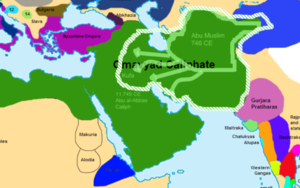 Map of the beginning of Abbasid revolt before the Battle of the Zab, which caused the fall of the dynasty.
Map of the beginning of Abbasid revolt before the Battle of the Zab, which caused the fall of the dynasty.
At this point Marwan mobilized his troops from Harran and advanced toward Iraq. In January of 750 the two forces met in the Battle of the Zab, and the Umayyads were defeated. Damascus fell to the Abbasids in April, and in August Marwan was killed in Egypt.
The victors desecrated the tombs of the Umayyads in Syria, sparing only that of Umar II, and most of the remaining members of the Umayyad family were tracked down and killed. One grandson of Hisham, Abd ar-Rahman I, survived and established a kingdom in Al-Andalus (Moorish Iberia), proclaiming his family to be the Umayyad Caliphate revived.
Previté-Orton argues that the reasons for the decline of the Umayyads was the rapid expansion of Islam. During Umayyad period, mass conversions brought Persians, Berbers, Copts, and Aramaics to Islam. These mawalis (clients) were often better educated and more civilised than their Arab masters. The new converts, on the basis of equality of all Muslims, transformed the political landscape. Previté-Orton also argues that the feud between Syria and Iraq, further weakened the empire.[12]
Umayyad administration
Central diwans
To assist the Caliph in administration there were six Boards at the Centre: Diwan al-Kharaj (the Board of Revenue), Diwan al-Rasa'il (the Board of Correspondence), Diwan al-Khatam (the Board of Signet), Diwan al-Barid (the Board of Posts), Diwan al-Qudat (the Board of Justice) and Diwan al-Jund (the Military Board)
Diwan al-Kharaj
The Central Board of Revenue administered the entire finance of the empire, it also imposed and collected taxes and disbursed revenue.
Diwan al-Rasa'il
A regular Board of Correspondence was established under the Umayyads. It issued state missives and circulars to the Central and Provincial Officers. It co-ordinated the work of all Boards and dealt with all correspondence as the chief secretariat.
Diwan al-Khatam
In order to check forgery Diwan al-Khatam (Bureau of Registry) a kind of state chancellery was instituted by Mu'awiyah. It used to make and preserve a copy of each official document before sealing and despatching the original to its destination. Thus in the course of time a state archive developed in Damascus by the Umayyads under Abd al-Malik. This department survived till the middle of the Abbasid period.
Diwan al-Barid
Mu'awiyah introduced postal service. Abd al-Malik extended it throughout his empire and Walid made full use of it. The Umayyad Caliph Abd al-Malik developed a regular postal service. Umar bin Abdul-Aziz developed it further by building caravanserais at stages along the Khurasan highway. Relays of horses were used for the conveyance of dispatches between the caliph and his agents and officials posted in the provinces. The main highways were divided into stages of 12 miles (19 km) each and each stage had horses, donkeys or camels ready to carry the post. Primarily the service met the needs of Government officials but travellers and their important dispatches were also benefitted by the system. For swift transport of troops also the postal carriages were used. They were able to carry fifty to a hundred men at a time. Under it Governor Yusuf bin Umar, the postal department of Iraq cost 4,000,000 dirhams a year.
Diwan al-Qudat
In the early period of Islam justice was administered by Muhammad and the orthodox Caliphs in person. After the expansion of the Islamic State Umar al-Faruq had to separate judiciary from the general administration and appointed the first qadi in Egypt as early as 23H/643AD. After 661AD a series of judges succeeded one after another in Egypt under the Umayyad Caliphs, Hisham and Walid II.
Diwan al-Jund
The Diwan of Umar(rali) assigning annuities to all Arabs and to the Muslim soldiers of other races underwent a change in the hands of the Umayyads. The Umayyads meddled with the register and the recipients regarded pensions as the subsistence allowance even without being in active service. Hisham reformed it and paid only to those who participated in battle. On the pattern of the Byzantine system the umayyads reformed their army organization in general and divided it into five corps: the centre, two wings, vanguards and rearguards while on march or in a battle field following the same formation. Marwan II (740–50) abandoned the old division and introduced Kurdus (cohort) a small compact body. The Umayyad troops were divided into three divisions: infantry, cavalry and artillery. Arab troops were dressed and armed in Greek fashion. The Umayyad cavalry used plain and round saddles. The artillery used arradah (ballista), manjaniq (the mangonel) and dabbabah or kabsh (the battering ram). The heavy engines, siege machines and baggage were carried on camels behind the army.
Social Organization
The Umayyad Caliphate exhibited four main social classes:
1.Muslim Arabs
2.Muslim non-Arabs (clients of the Muslim Arabs)
3.Non-Muslim free persons (Christians, Jews, Zoroastrians)
4.Slaves
The Muslim Arabs were at the top of the society, and saw it as their duty to rule over the conquered areas. Despite the fact that Islam teaches the equality of all Muslims, the Arab Muslims held themselves in higher esteem than Muslim non-Arabs and generally did not mix with other Muslims.
The inequality of Muslims in the empire led to social unrest. As Islam spread, more and more of the Muslim population became non-Arabs. This caused tension as the new converts were not given the same rights as Muslim Arabs. Also, as conversions increased, tax revenues off non-Muslims decreased to dangerous lows. These issues continued to grow until they helped cause the Abbasid Revolt in the 740s.[13]
Legacy
Historical significance
History of the Levant Stone Age Kebaran culture · Natufian culture
Halafian culture · Ghassulian culture · JerichoAncient history Sumerians · Ebla · Akkadian Empire
Canaan · Phoenicians · Amorites
Aramaeans · Edomites · Hittites
Nabataeans · Palmyra · Philistines
Israel and Judah
Assyrian Empire · Babylonian Empire
Achaemenid Empire · Seleucid Empire
Hasmonean kingdom
Roman Empire · Byzantine EmpireMiddle Ages Rashidun · Umayyads
Abbasids · Fatimids
Crusades · Ayyubids · MamluksModern history Ottoman Empire
British Mandate of Palestine
Cyprus
Syria · Lebanon · Jordan · Iraq
Israel · Palestinian territories
The Umayyad caliphate was marked both by territorial expansion and by the administrative and cultural problems that such expansion created. Despite some notable exceptions, the Umayyads tended to favor the rights of the old Arab families, and in particular their own, over those of newly converted Muslims (mawali). Therefore they held to a less universalist conception of Islam than did many of their rivals. As G.R. Hawting has written, "Islam was in fact regarded as the property of the conquering aristocracy."[14]
According to one common view, the Umayyads transformed the caliphate from a religious institution (during the rashidun) to a dynastic one.[15] However, the Umayyad caliphs do seem to have understood themselves as the representatives of God on earth, and to have been responsible for the "definition and elaboration of God's ordinances, or in other words the definition or elaboration of Islamic law."[16]
During the period of the Umayyads, Arabic became the administrative language. State documents and currency were issued in the language. Mass conversions brought a large influx of Muslims to the caliphate. The Umayyads also constructed famous buildings such as the Dome of the Rock at Jerusalem, and the Umayyad Mosque at Damascus.[15]
The Umayyads have met with a largely negative reception from later Islamic historians, who have accused them of promoting a kingship (mulk, a term with connotations of tyranny) instead of a true caliphate (khilafa). In this respect it is notable that the Umayyad caliphs referred to themselves, not as khalifat rasul Allah ("successor of the messenger of God", the title preferred by the tradition) but rather as khalifat Allah ("deputy of God"). The distinction seems to indicate that the Umayyads "regarded themselves as God's representatives at the head of the community and saw no need to share their religious power with, or delegate it to, the emergent class of religious scholars."[17]
In fact, it was precisely this class of scholars, based largely in Iraq, that was responsible for collecting and recording the traditions that form the primary source material for the history of the Umayyad period. In reconstructing this history, therefore, it is necessary to rely mainly on sources, such as the histories of Tabari and Baladhuri, that were written in the Abbasid court at Baghdad.
Modern Arab nationalism regards the period of the Umayyads as part of the Arab Golden Age which it sought to emulate and restore. This is particularly true of Syrian nationalists and the present-day state of Syria, centered like that of the Umayyads on Damascus. White, one of the four Pan-Arab colors which appear in various combinations on the flags of most Arab countries, is considered as representing the Umayyads.
Theological opinions concerning the Umayyads
Sunni opinions
Sunni opinions of the Umayyad dynasty after Muawiyah are typically dim, viewing many of the rulers as sinners and the cause of great tribulation in the Ummah[citation needed]. For example, in the section concerning Quran 17:60[18] in the exegesis by al-Suyuti entitled Dur al-Manthur, the author writes that there exist traditions which describe the Umayyads as "the cursed tree". There are some exceptions to this – Umar ibn Abd al-Aziz is commonly praised as one of the greatest Muslim rulers after the four Rightly Guided Caliphs.
Shi'a opinions
The negative view of the Umayyads of Shias is briefly expressed in the Shi'a book "Sulh al-Hasan".[19][20] According to some sources Ali described them as the worst Fitna.[21]
Other religions
Bahá'í standpoint
In Some Answered Questions, `Abdu'l-Bahá asserts that the Umayyad dynasty was the "great red dragon, having seven heads and ten horns, and seven crowns upon his heads" and that the Umayyads "rose against the religion of Prophet Muhammad and against the reality of Ali".[22]
The seven heads of the dragon is symbolic of the seven provinces of the lands dominated by the Umayyads; Damascus, Persia, Arabia, Egypt, Africa, Andalusia, and Transoxania. The ten horns represent the ten names of the leaders of the Umayyad dynasty; Abu Sufyan, Muawiya, Yazid, Marwan, Abd al-Malik, Walid, Sulayman, Umar, Hisham, and Ibrahim. Some names were re-used as in the case of Yazid II and Yazid III were not counted for this interpretation.
Leaders
 Genealogic tree of the Umayyad family. In blue: caliph Uthman, one of the four Rashidun Caliphs. In green, the Umayyad Caliphs of Damascus. In yellow, the Umayyad emirs of Córdoba. In orange, the Umayyad Caliphs of Córdoba. Abd Al-Rahman III was an emir until 929 when he proclaimed himself Caliph. Muhammad is included (in caps) to show the kinship of the Umayyads with him.
Genealogic tree of the Umayyad family. In blue: caliph Uthman, one of the four Rashidun Caliphs. In green, the Umayyad Caliphs of Damascus. In yellow, the Umayyad emirs of Córdoba. In orange, the Umayyad Caliphs of Córdoba. Abd Al-Rahman III was an emir until 929 when he proclaimed himself Caliph. Muhammad is included (in caps) to show the kinship of the Umayyads with him.
Political
Ruler Reign Caliphs of Damascus Muawiyah I ibn Abi Sufyan 661 – 680 Yazid I ibn Muawiyah 680 – 683 Muawiyah II ibn Yazid 683 – 684 Marwan I ibn al-Ḥakam 684 – 685 Abd al-Malik ibn Marwan 685 – 705 al-Walid I ibn Abd al-Malik 705 – 715 Suleiman ibn Abd al-Malik 715 – 718 Umar ibn Abd al-Aziz 717 – 720 Yazid II ibn Abd al-Malik 720 – 724 Hisham ibn Abd al-Malik 724 – 743 al-Walid II ibn Yazid II 743 – 744 Yazid III ibn al-Walid 744 Ibrahim ibn al-Walid 744 Marwan II ibn Muhammad (ruled from Harran in the Jazira) 744 – 750 Emirs of Cordoba Abd ar-Rahman I 756 – 788 Hisham I 788 – 796 al-Hakam I 796 – 822 Abd ar-Rahman II 822 – 852 Muhammad I of Córdoba 852 – 886 Al-Mundhir 886 – 888 Abdallah ibn Muhammad 888 – 912 Abd ar-Rahman III 912 – 929 Caliphs of Cordoba Abd ar-Rahman III, as caliph 929 – 961 Al-Hakam II 961 – 976 Hisham II 976 – 1008 Mohammed II 1008 – 1009 Suleiman 1009 – 1010 Hisham II, restored 1010 – 1012 Suleiman, restored 1012 – 1017 Abd ar-Rahman IV 1021 – 1022 Abd ar-Rahman V 1022 – 1023 Muhammad III 1023 – 1024 Hisham III 1027 – 1031 Religious Umayyad
- Marwan ibn al-Hakam
- Muawiyah ibn Abi Sufyan
- Abu Sufiyan ibn Harb
See also
History of Al-Andalus
711–1492711–732 Muslim conquest
- Battles : Battle of Guadalete
Battle of Toulouse | Battle of Tours
756–1031 Omayyads of Córdoba
1009–1106 First Taifa period
1085–1145 Almoravid rule
- Almoravid conquest
- Battle of Sagrajas
1140-1203 Second Taifa period
1147–1238 Almohad rule
1232–1287 Third Taifa period
1238–1492 Emirate of Granada
connected articles - Map of Al-Andalus
- Reconquista
- Timeline of the Muslim presence in the Iberian peninsula
- al-Andalus
- Umayya ibn Abd Shams
- Caliphate of Córdoba
- History of Islam
- Caliphate
- List of Sunni Muslim dynasties
References
- ^ http://www.historiansagainstwar.org/resources/Islamic_History&Literature.pdf
- ^ Blankinship, Khalid Yahya (1994), The End of the Jihad State, the Reign of Hisham Ibn 'Abd-al Malik and the collapse of the Umayyads, State University of New York Press, p. 37, ISBN 0791418278
- ^ "Muslim Congress". http://www.muslimcongress.org/contentmc/services/muharram.aspx. Retrieved 2008-06-30.
- ^ Sunan Abu Dawud: Book 14, Number 2659
- ^ Ibn Ishaq (1955) 380—388, cited in Peters (1994) p. 218
- ^ Watt (1956), p. 66
- ^ Britannica Encyclopedia, Karbala', Battle of
- ^ Ibn Taymiya, in his A Great Compilation of Fatwa
- ^ Ibn Kathir: Al-Bidayah wal-Nihayah, Volume 8 page 164
- ^ G.R. Hawting, The first dynasty of Islam (London, 2000), p.28.
- ^ R.M. Foote et al., Report on Humeima excavations, in V. Egan and P.M. Bikai, "Archaeology in Jordan", American Journal of Archaeology 103 (1999), p. 514.
- ^ Previté-Orton (1971), vol. 1, pg. 239
- ^ Ochsenwald, William (2004). The Middle East, A History. McGraw Hill. pp. 55-56. ISBN 0072442336.
- ^ G.R. Hawting, The first dynasty of Islam: the Umayyad caliphate, AD 661–750 (London, 2000), 4.
- ^ a b Previté-Orton (1971), pg 236
- ^ P. Crone and M. Hinds, God's caliph: religious authority in the first centuries of Islam (Cambridge, 1986), p. 43.
- ^ G.R. Hawting, The first dynasty of Islam: the Umayyad caliphate, AD 661–750 (London, 2000), 13.
- ^ http://www.usc.edu/dept/MSA/quran/017.qmt.html. Note: (THE LINK TAKES YOU TO CHAPTER 17 AND NOT CHAPTER 60)
- ^ Sulh al-Hasan
- ^ [1] Chapter 24
- ^ Sermon 92
- ^ `Abdu'l-Bahá (1990) [1908]. Some Answered Questions. Wilmette, Illinois: Bahá'í Publishing Trust,. pp. 69. ISBN 0-87743-190-6. http://reference.bahai.org/en/t/ab/SAQ/saq-13.html#pg69.
Further reading
- A. Bewley, Mu'awiya, Restorer of the Muslim Faith (London, 2002)
- P. Crone, Slaves on horses (Cambridge, 1980).
- P. Crone and M.A. Cook, Hagarism (Cambridge, 1977).
- F.M. Donner, The early Islamic conquests (Princeton, 1981).
- G.R. Hawting, The first dynasty of Islam: the Umayyad caliphate, AD 661–750 Rutledge Eds. (London, 2000]
- H. Kennedy, The Prophet and the age of the caliphates: the Islamic Near East from the sixth to the eleventh century (London, 1986).
- Previté-Orton, C. W (1971). The Shorter Cambridge Medieval History. Cambridge: Cambridge University Press.
- J. Wellhausen, The Arab Kingdom and its fall (London, 2000).
External links
- Umayyads
- Umayyads – First caliphate dynasty
- Timeline of Islamic caliphs by Happy Books
- Interactive Family tree of Umayyah ibn Abd Shams by Happy Books
Umayyad Caliphs Caliphs of Damascus
(661–750)Muawiya I · Yazid I · Muawiya II · Marwan I · Abd al-Malik · Al-Walid I · Sulayman · Umar II · Yazid II · Hisham · Al-Walid II · Yazid III · Ibrahim · Marwan IIEmirs of Córdoba
(756–929)Abd ar-Rahman I · Hisham I · Al-Hakam I · Abd ar-Rahman II · Muhammad I · Al-Mundhir · Abdullah · Abd-ar-Rahman IIICaliphs of Córdoba
(929–1031)Abd-ar-Rahman III · Al-Hakam II · Hisham II · Muhammad II · Sulayman · Hisham II · Sulayman · Ali ibn Hammud al-Nasir[H] · Abd ar-Rahman IV · Al-Qasim ibn Hammud al-Ma'mun[H] · Yahya ibn Ali al-Mu'tali[H] · Al-Qasim ibn Hammud al-Ma'mun[H] · Abd ar-Rahman V · Muhammad III · Yahya ibn Ali al-Mu'tali[H] · Hisham IIITimeline of the Caliphate 
A history of empires Ancient empires Medieval empires Byzantine · Hunnic · Arab (Rashidun · Umayyad · Abbasid · Fatimid · Caliphate of Córdoba · Ayyubid) · Moroccan (Idrisid · Almoravid · Almohad · Marinid) · Persian (Tahirid · Samanid · Buyid · Sallarid · Ziyarid) · Ghaznavid · Bulgarian (First · Second) · Benin · Great Seljuq · Oyo · Bornu · Khwarezmian · Aragonese · Timurid · Indian (Chola · Gurjara-Pratihara · Pala · Eastern Ganga dynasty · Delhi) · Mongol (Yuan · Golden Horde · Chagatai Khanate · Ilkhanate) · Kanem · Serbian · Songhai · Khmer · Carolingian · Holy Roman · Angevin · Mali · Chinese (Sui · Tang · Song · Yuan) · Wagadou · Aztec · Inca · Srivijaya · Majapahit · Ethiopian (Zagwe · Solomonic) · Somali (Ajuuraan · Warsangali) · AdaliteModern empires Tongan · Indian (Maratha · Sikh · Mughal) · Chinese (Ming · Qing) · Ottoman · Persian (Safavid · Afsharid · Zand · Qajar · Pahlavi) · Moroccan (Saadi · Alaouite) · Ethiopian · Somali (Dervish · Gobroon · Hobyo) · French (First · Second) · Austrian (Austro-Hungarian) · German · Russian · Swedish · Mexican (First · Second) · Brazil · Korea · Japan · Haitian (First · Second) · Central AfricanColonial empires Categories:- Former countries in Asia
- Former empires
- States and territories established in 661
- States and territories disestablished in 750
- Umayyad Caliphate
- Arab dynasties
- History of Saudi Arabia
- Muslim dynasties
- 750 disestablishments
- History of Islam
- Al-Andalus
- States in medieval Anatolia
- History of Iran
- History of North Africa
- History of the Mediterranean
Wikimedia Foundation. 2010.


